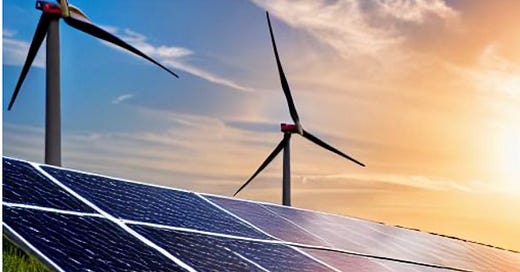Earth 2: A sunny, windy paradise
For most people, clean energy is synonymous with two types of energy technologies: solar panels and wind turbines. As an illustrative example, when I searched ‘clean energy’ on Google, the first 18 images were of solar panels and wind turbines. For many people, their vision of a clean energy future is one dominated by these two energy technologies. Therefore, it is only fitting to start our exploration with these two popular clean energy technologies.
For this and every energy technology, I’ll answer a few questions that will help us better understand it.
Do these technologies have the potential to power the world?
Is there enough solar energy hitting the earth and wind blowing to sustain our energy needs now and into the foreseeable future? Luckily for us, the answer is yes. Every year, ~1.5 billion TWh of solar energy hits the earth, and at least ~0.9 million TWh of energy can be generated from wind. In comparison, the global energy use last year was ~0.18 million TWh. Now, this energy is distributed worldwide (including the oceans), so harnessing all of it would be extremely difficult. Still, there is enough solar and wind potential out there to sustain our energy needs.
Can we make energy cheaply enough from these technologies?
Typically, when people talk about energy costs, they’re referring to something called the Levelized Cost of Energy (LCOE). This is an estimate of how much the average energy cost from a generator over its lifetime would be. By this measure, the cost of solar and wind energy has plummeted over the past decade and a half. Solar saw a drop from an LCOE of ~360 $/MWh in 2009 to ~36 $/MWh in 2021. That is a 10-fold price drop in 12 short years! Wind saw a similar (though more modest) drop, with its LCOE going from ~135 $/MWh in 2009 to ~38 $/MWh in 2021.
While it is easy to look at these trends and project costs coming down indefinitely, historical trends don’t necessarily predict future costs. In the case of both solar and wind, their LCOEs in 2023 were much higher than in 2021 (~60 $/MWh for solar and ~50 $/MWh for wind). There are many reasons for this increase in prices including higher interest rates and increases in the cost of raw materials and construction labor. It is, therefore, unclear where solar and wind prices will end up in 2024 and beyond.
How do these prices compare with other technologies? Well, they are much lower than the average electricity price in the US (~120 $/MWh). However, the significant differences are that this includes electricity distribution (i.e., the electricity grid that transports the electricity to your house) and that most conventional electricity generators (ie gas, coal and nuclear plants) operate when there is demand for their electricity and are powered off (or run at a lower rate) when demand goes down.
Additionally, while energy and electricity are often conflated, they are not the same thing. Electricity in the US accounts for only ~37% of all energy use, with the rest primarily being petroleum (for use in transportation and industrial processes) and natural gas (for use in heating and industrial processes). Natural gas is usually much cheaper than electricity, with the average industrial natural gas prices last year in the US only ~2.5 $/mmbtu. That is equivalent to ~0.85 $/MWh! Thus, barring massive reductions in solar and wind electricity prices, they will remain much more expensive than natural gas. On the other hand, liquid fuels (such as diesel and gasoline) tend to be more expensive, with gasoline prices in the US ~3.5 $/gal on average last year (equivalent to ~100 $/MWh).
Do we have access to energy from these technologies whenever we want?
In contrast to conventional energy sources, solar and wind generators produce electricity when the sun is shining or the wind is blowing. Therefore, if we want most (if not all) electricity to come from solar and wind sources, we will need ways to store vast amounts of electricity in times of excess to be deployed later on. Many companies are working on methods to store electricity for short durations (typically 4-8 hours) and much longer durations (8+ hours). Short- and long-term energy storage will be needed because solar and wind energies vary from hour to hour (no solar at night!) and month to month (e.g., solar output is much lower in December than in July in the northern hemisphere). While these technologies are exciting, they significantly increase the price of electricity. It is estimated that adding 4 hours of storage to solar or wind increases its total cost by ~20-30 $/MWh, and it is likely that longer duration storage will be even more expensive.
Do all countries and geographies have access to these energy technologies?
While some geographies and regions have more access to solar or wind energy, these resources are well distributed, and most countries can generate significant amounts of electricity from wind and solar energy. That said, for certain countries with limited solar and onshore wind availability (like Japan and Korea), that may entail the construction of substantial amounts of offshore systems which tend to be much more expensive.
Conclusion
Solar and wind jointly account for ~5% of global electricity production and will undoubtedly be part of our clean energy future. However, how large a role they play will depend on several factors, including their total cost and the cost of energy storage.
The next post will focus on one of the most popular alternative clean energy futures - one dominated by nuclear power. Stay tuned!



